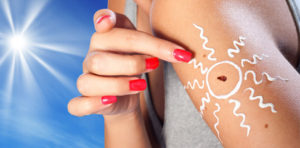
Who wants to be indoors on our glorious summer days in New Jersey? And, while we’re long past the days of the Coppertone Girl and her serious tan lines, many of us still neglect the signs of skin cancer when they show up on our skin. Truth is, skin cancer is the most frequently occurring cancer in the U.S., and it shows no preference for age, race, or skin type.
The key to beating skin cancer is to catch it early. Toward that end, Dr. Hetzler wants his patients to be knowledgeable about the warning signs, so here is some additional information on skin cancer. Of course, should it become necessary, Dr. Hetzler specializes in removing melanoma, the most dangerous form of skin cancer. Still, prevention is best.
Who gets skin cancer?
It seems almost unfair — some people get skin cancers seemingly all over their bodies while their darker-skinned friends don’t ever get anything. Why is this? It all comes down to melanin. Melanin is the pigment in the skin that helps protect it from the sun. Melanin is what is responsible for turning the skin a darker tone (tanning) after receiving sun exposure. This is a protection mechanism.
People with fair skin have less melanin, so they are less protected. The ultraviolet rays from the sun can alter the genetic material in skin cells, causing them to mutate into cancerous cells. It is estimated that 40 to 50% of people with fair skin (who live to be at least 65 years of age) will develop at least one skin cancer in their lives.
Different cancers
There are three types of skin cancer: squamous cell, basic cell, and melanoma. Squamous cell carcinomas and basal cell carcinomas are more common than melanoma and they come from different types of sun exposure. Squamous and basal cell carcinomas are the result of the amount of overall sun exposure. Fair-skinned people who spend a lot of time outdoors will likely develop one of these two skin cancers. Melanoma, the most dangerous type of skin cancer, isn’t thought to come from prolonged sun exposure, but from the intensity of that exposure. The thinking is that melanoma is triggered by those scorching types of sunburns where the person’s skin blisters and peels afterwards. Research has shown that just one blistering sunburn during childhood doubles a person’s risk for developing melanoma later in life.
The danger with melanoma comes from its potential to spread cancer throughout the body. Melanoma doesn’t stay on the skin’s surface. It grows downwards and, if left alone, will eventually deposit cancer cells into the bloodstream where they can then create new cancer growths anywhere in the body. That’s why early melanoma excision with Dr. Hetzler is so important.
Know your ABCDEs
If Dr. Hetzler tells you to mind your alphabet when it comes to your skin, here’s what he means. These five letters can come in handy when looking for skin cancers on your skin.
- Asymmetry— If one half of the mole doesn’t match the other half, that’s a concern. Normal moles are symmetrical.
- Border— If the border or edges of your mole are ragged, blurred, or irregular, that is a reason to call Dr. Hetzler. Melanoma lesions often have irregular borders.
- Color— Normal moles are a single shade throughout. If your mole has changed color or if it has different shades of tan, brown, black, blue, white, or red, then it should be checked.
- Diameter— If a mole is larger than the eraser of a pencil it needs to be checked.
- Evolving— If a mole evolves by shrinking, growing larger, changing color, itching or bleeding, or other changes it should be checked. Melanoma lesions often grow in size or gain height rapidly.
No matter your skin type, we all need to be on the lookout for skin cancer. If you’ve been minding your ABCDEs and something has caught your eye, call Dr. Hetzler to set up an appointment, 732-219-0447.

No comments yet.